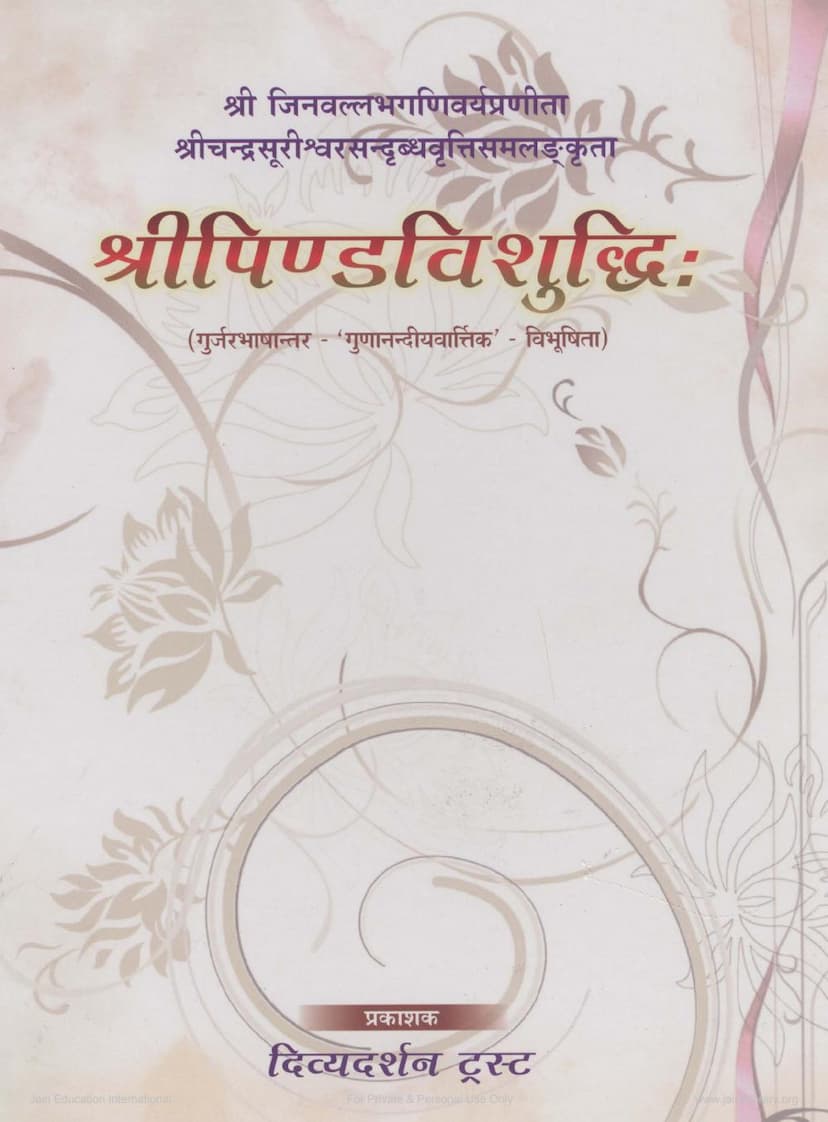Pind Vishuddhi
Added to library: September 2, 2025

Summary
Based on the provided text, here is a comprehensive summary of the Jain text "Pind Vishuddhi" by Kulchandrasuri and Punyaratnasuri, published by Divya Darshan Trust:
Book Title: Shri Pind Vishuddhi Author(s): Kulchandrasuri, Punyaratnasuri Publisher: Divya Darshan Trust
Core Subject:
The "Pind Vishuddhi" (पिण्डविशुद्धि) is a significant Jain text that delves deeply into the concept of Pind Vishuddhi, which translates to the purity of alms or food received by monks and nuns. It is considered a profound treatise on ethical and practical guidelines for ascetics regarding their food intake, aiming to ensure it is free from impurities and spiritual defilements.
Key Textual Information:
- Original Author: The text is based on the original work by Shri Jinvallabh Ganivarya (श्री जिनवल्लभ गणि)।
- Commentary: The current text is enriched with a commentary (Vritti) by Shri Chandrasurishwarji (श्रीचन्द्रसूरीश्वरजी).
- Gujarati Translation/Commentary: The publication also includes a Gujarati translation and commentary known as 'Gunandiya Vartik' (गुणानन्दीय वार्तिक), further enhancing the accessibility and understanding of the text.
- Inspiration and Dedication: The publication is a tribute to the birth centenary year of Shri Bhuvanbhanu Suri (श्री भुवनभानु सूरीश्वरजी), indicating a lineage of respected Jain scholars and monks. The book is dedicated to him with great reverence.
- Guiding Inspiration: The work is inspired by the guidance of Acharya Dev Shrimad Vijay Jayghosh Surishwarji (आचार्यदेव श्रीमद्विजय जयघोषसूरीश्वराः).
- Research and Revision: The text was researched and revised by Acharya Dev Shrimad Vijay Kulchandrasurishwarji (वैराग्यवारिधि-आचार्यदेव-श्रीमद्विजय-कुलचन्द्रसूरीश्वराः) and Acharya Dev Shrimad Vijay Punyaratnasurishwarji (वर्धनतपोनिधि-आचार्यदेव-श्रीमद्विजय-पुण्यरत्नसूरीश्वराश्च).
- Vartikkar (Commentator): The commentary for the Gujarati translation, 'Gunandiya Vartik', was written by Munishri Bhanuvijay (मुनि भानुविजय), who is a disciple of Nyayavisharad Vardhmana Taponnidhi Acharya Dev Shrimad Vijay Bhuvanbhanu Surishwarji.
Content and Themes:
The "Pind Vishuddhi" is described as a "grand elixir of self-purification" (आत्मशुद्धिનું ભવ્ય રસાયણ). The text focuses on the meticulous and spiritually significant practice of 'Pinde-eshana' (पिंडे-षणा), which refers to the seeker's (monk's) process of obtaining alms or food.
The summary from Page 7 highlights the Jain philosophy's unique approach to food acquisition:
- Bhiksacharya as a Great Yoga: Jainism elevates the act of begging for alms (भिक्षाचर्या) from mere sustenance to a profound spiritual practice or "yoga." Monks are not beggars but "great yogis" (महान भिक्षायोगियों).
- Highest Standard of Food Code: Jain Dharma is presented as the only religion that has discovered the "highest standard of food code" (सर्वश्रेष्ठ उच्चतम कक्षा की आहारसंहिता).
- Absence of Harm: This code ensures that even while subsisting on alms, a monk can truthfully state, "We sustain ourselves, but no living being is harmed in it" (वयं च वित्तं नग्मानं न य जोडवदम्मद्). This signifies the profound ethical consideration in their food-gathering practices.
- Detailed Prohibition of Flaws: The text, drawing from scriptures like the Dashavaikalik Sutra and Acharnanga Sutra, along with the Pind Niryukti Shastra, elaborates on the concept of "Pind Vishuddhi." It meticulously details numerous flaws (doshas) that can affect alms, categorized into:
- Udgam Doshas (१६): Flaws related to the origin or acquisition of alms.
- Utpadana Doshas (१६): Flaws related to the preparation or creation of alms.
- Aeshana Doshas (१०): Flaws related to the receiving or accepting of alms.
- In total, the text addresses 64 flaws (this is derived from 16+16+10+12=54 mentioned in the table of contents, with some possible overlap or slightly different categorizations). The text explains 32 flaws in Udgam and Aeshana alone.
Commentary and Elaboration:
- Chandrasurishwarji's Commentary: Acharya Chandrasurishwarji's Sanskrit commentary (written in 1178 VS) is highly valued for clarifying the text with extensive scriptural examples.
- Padaliptasuri's Example: The text mentions the exemplary life of Acharya Padaliptasurishwarji, highlighting his devotion to the Sangha (community) even when faced with personal temptation or royal requests, emphasizing the paramount importance of the Sangha in Jainism.
- Specific Examples: The text references the detailed explanations of "mantra-pind dosha" (mantra-associated alms flaws) and provides insights into the character of great souls.
- Structure of the Text: The book includes a comprehensive index (Vishayanukramanika) detailing chapters and topics, including:
- Mangala (auspicious invocations) by the commentator and original author.
- Detailed discussions on various types of flaws (Udgam, Aeshana, Utpadana).
- Numerous illustrative stories and examples (drishtantas) to explain these flaws.
- Appendices (Parishisht) containing the original verses, Sanskrit-Prakrit glossaries, and charts.
Overall Purpose:
The "Pind Vishuddhi" serves as a guide for Jain ascetics to maintain the highest level of purity in their alms, which is considered crucial for their spiritual progress, adherence to non-violence, and the attainment of liberation (moksha). The text emphasizes that the purity of the mind is directly linked to the purity of the food consumed. It aims to equip the renunciates with the knowledge and discipline required to navigate the complexities of obtaining and consuming alms without spiritual compromise.
In essence, "Pind Vishuddhi" is a foundational text for Jain monastic discipline, providing a rigorous and ethical framework for the ascetic's relationship with food, rooted in the principle of non-violence and the pursuit of spiritual purification.